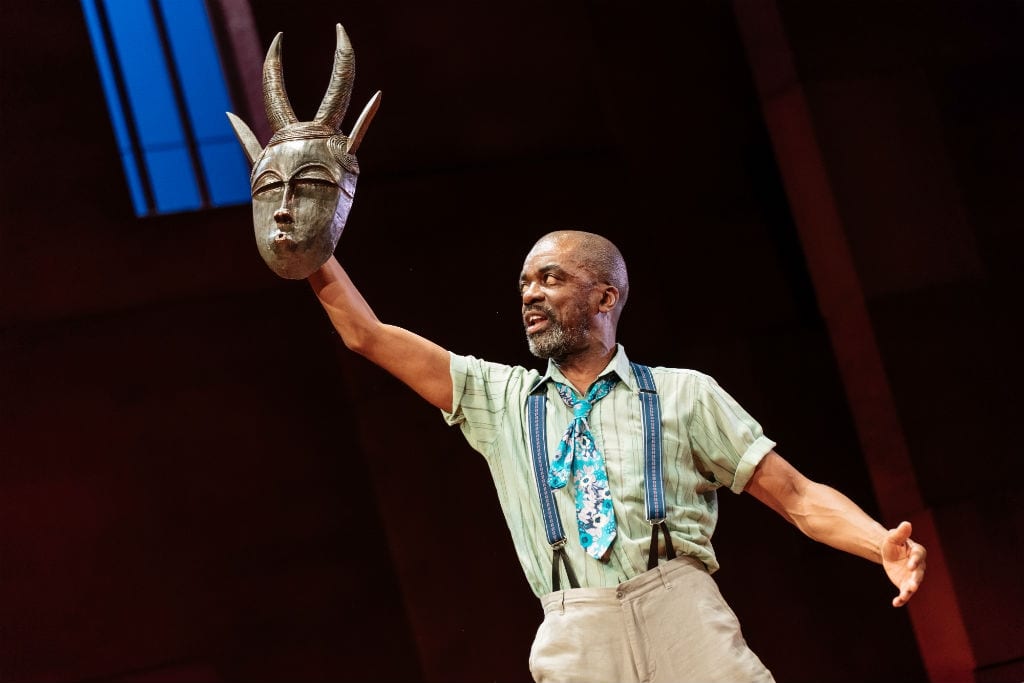You will walk away from RSC’s Hamlet with colors exploding in your mind’s eye. Costumes, drapes, headdresses, paintings, and pieces of the set are bright, bold, and awe-inspiring. But the aesthetic of this production of Hamlet is only the most tangible part of the show – it only scratches the surface of this journey you are about to embark on, through familiar dramatic terrain but in a new and wonderful Denmark.
Director Simon Godwin and the Royal Shakespeare Company first presented this stunning run of Hamlet at Stratford-upon-Avon in 2016. Godwin tackles Shakespeare’s Danish prince with a West African twist inspired by Paapa Essiedu, the British actor of Ghanaian descent who plays Hamlet. African patterns and rituals are infused in every element of the Danish court, culminating in the beautifully choreographed, beautifully staged hand-to-hand combat match between Hamlet and Laertes in the final act. And there are African drummers scattered throughout the scenes of Godwin’s Hamlet, heralding the arrival of the king and queen or warning of something ominous. The drums create a sense of royalty and authority, but also an homage to something ancient and otherworldly. This is especially true as you watch the young Hamlet convulsing to the beat of the drums until the ghost of his father finally reveals himself, stepping calmly from the void in brightly colored robes. There is a sense that he is giving something of himself to meet this ghost before he even knows what it is that his father wants from him.

We see Hamlet graduating from college (“Wittenberg University”) in a brief prologue scene – he is a young man who values his close friends, a scholar who takes pleasure in his earned as well as natural intelligence, and seems as of yet to have been untested by the world. Just as Shakespeare unquestionably wrote Hamlet to be the star of the show with his quick wit and his fearsome supply of lines, Paapa Essiedu is unequivocally the heart and soul of Godwin’s Hamlet. His titular character is young, sometimes rash, and yet fiercely intelligent, delighted by his own wit, especially as it eases the burden of his reluctant revenge. He moves across the stage with grace, dexterity, and sometimes even playfulness—and through the nuances of his well-worn character as well. In his hands, the Danish Prince is polished and cut to reveal hidden facets – anger, violence, indecision, but also savoring his fraternity, tenderness, and longing. Essiedu practically vibrates with energy throughout his performance, even as he soliloquizes alone onstage with Hamlet’s tears in his eyes.

Hamlet’s antic disposition leaves in its wake chaotic pastels and scribbled drawings, plastered across tapestries, furniture, his clothing, and his face. Paint-smeared Hamlet strikes a stark contrast with the bold colors and geometric patterns of the Ghanaian-inspired court, especially the regal Gertrude (Lorna Brown) and the decidedly modern Ophelia (Mimi Ndiweni). Though she is conscripted as the fair maiden doomed to die, Ndiweni’s Ophelia is bright and bubbly, mocking her brother and supporting her father. She is no lovesick girl, though it is clear that she cares about Hamlet. My favorite moment of this Ophelia is the scene in which she hands out flowers to the king and queen – but instead of real flowers, as is often done, she quite graphically rips her own hair out of her head. Other characters like the babbling Polonius, the devious Claudius, or the steadfast Horatio are played more or less as they often are, but the quality of the actors and the way they interact with words and body language makes them a joy to watch.
All told, with a phenomenal cast and a transcendent contextual upgrade, the Royal Shakespeare Company’s Hamlet soars. Every recitation, every twist of fate hits like an untold story. And though you know it’s coming, Hamlet’s every last desperate, labored breath feels like a new, devastating blow. If you are lucky enough to be near the Kennedy Center during Hamlet’s short American run, take advantage and let yourself be transported.

